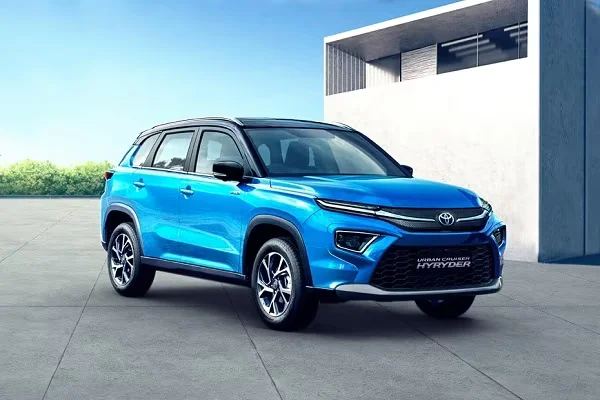Hyundai Verna vs Toyota Yaris
In 2024 when choosing between the Hyundai Verna and Toyota Yaris, assess both models based on Price, Size, Space, Boot Space, Service cost, Mileage, Features, and Colours. In 2024 when choosing between the Hyundai Verna and Toyota Yaris, assess both models based on Price, Size, Space, Boot Space, Service cost, Mileage, Features, and Colours. Hyundai Verna Price starts at Rs. 10.96 Lakhs (ex-showroom price) for EX 1.5 Petrol MT, Toyota Yaris Price starts at Rs. 9.16 Lakhs (last recorded price) for J MT OPT. Verna: 1482 cc engine, 18.6 to 20.6 kmpl mileage. Yaris: 1496 cc engine, 17.1 kmpl mileage. Read the expert reviews to determine comfort and performance.
Verna vs Yaris Comparison
...Read MoreRead LessSpecificationsFeaturesPriceEMIExpert RatingPros and ConsPopular ComparisonsTop AutoMobilesLatest NewsLatest Videos
Specification
Engine & Transmission
| Engine Type | |
| 1.5 l MPi | 1.5L Dual VVT-i Engine |
| Driving Range | |
| 837 Km | - |
| Max Torque (Nm@rpm) | |
| 143.8 Nm @ 4500 rpm | 140 Nm @ 4200 rpm |
| Transmission | |
| Manual - 6 Gears | Manual - 6 Gears |
| Mileage (ARAI) | |
| 18.6 kmpl | 17.1 |
| Max Power (bhp@rpm) | |
| 113 bhp @ 6300 rpm | 106 bhp @ 6000 rpm |
| Drivetrain | |
| FWD | FWD |
| Emission Standard | |
| BS6 Phase 2 | BS 6 |
| Engine | |
| 1497 cc, 4 Cylinders Inline, 4 Valves/Cylinder, DOHC | 1496 cc, 4 Cylinders Inline, 4 Valves/Cylinder, DOHC |
| Fuel Type | |
| Petrol | - |
Suspensions, Brakes, Steering & Tyres
| Minimum Turning Radius | |
| 5.2 metres | 5.1 |
| Rear Brake Type | |
| Drum | Drum |
| Spare Wheel | |
| Steel | Steel |
| Front Tyres | |
| 185 / 65 R15 | 185 / 60 R15 |
| Wheels | |
| Steel Rims | Alloy Wheels |
| Steering Type | |
| Power assisted (Electric) | Power assisted (Electric) |
| Front Brake Type | |
| Disc | Disc |
| Front Suspension | |
| McPherson Strut with Coil Spring | McPherson Strut with stabiliser |
| Rear Suspension | |
| Couple Torsion Beam Axle | Torsion beam with stabiliser |
| Rear Tyres | |
| 185 / 65 R15 | 185 / 60 R15 |
Dimensions & Weight
| Length | |
| 4535 mm | 4425 |
| Wheelbase | |
| 2670 mm | 2550 |
| Height | |
| 1475 mm | 1495 |
| Width | |
| 1765 mm | 1730 |
Capacity
| Bootspace | |
| 528 litres | 476 |
| Seating Capacity | |
| 5 Person | 5 |
| Doors | |
| 4 Doors | 4 |
| Fuel Tank Capacity | |
| 45 litres | 42 |
Features
Comfort & Convenience
| Steering Adjustment | |
| Tilt | Tilt |
| Parking Sensors | |
| Rear | Rear |
| Vanity Mirrors on Sun Visors | |
| Co-Driver Only | Driver & Co-Driver |
| Keyless Start/ Button Start | |
| No | No |
| Parking Assist | |
| No | No |
| Air Conditioner | |
| Yes (Manual) | Yes (Manual) |
| Anti-glare Mirrors | |
| Manual - Internal Only | Manual - Internal Only |
| Heater | |
| Yes | Yes |
| Cruise Control | |
| No | No |
| 12V Power Outlets | |
| 1 | Yes |
| Front AC | |
| Single Zone, Common Fan Speed Control | Common Fan Speed Control |
| Rear AC | |
| Vents Behind Front Armrest | - |
Instrumentation
| Adjustable Cluster Brightness | |
| No | Yes |
| Trip Meter | |
| Electronic 2 Trips | 2 Trips |
| Shift Indicator | |
| Yes | No |
| Clock | |
| Digital | Digital |
| Door Ajar Warning | |
| Yes | Yes |
| Low Fuel Level Warning | |
| Yes | Yes |
| Tachometer | |
| Analogue | Analogue |
| Instantaneous Consumption | |
| Yes | Yes |
| Gear Indicator | |
| No | No |
| Instrument Cluster | |
| Analogue - Digital | Analogue |
| Average Speed | |
| Yes | Yes |
| Average Fuel Consumption | |
| Yes | Yes |
| Distance to Empty | |
| Yes | Yes |
Rear row
Price (On-Road BreakUp)
| On-Road Price | |
| ₹12,73,027 | ₹10,21,641 |
| Ex-Showroom Price | |
| ₹10,96,500 | ₹9,16,000 |
| RTO | |
| ₹1,21,650 | ₹64,150 |
| Insurance | |
| ₹54,377 | ₹40,991 |
| Accessories Charges | |
| ₹0 | ₹0 |
| FastTag Charges | |
| ₹500 | ₹500 |
| Other Charges | |
| ₹0 | ₹0 |
EMI
| ₹27,362 | ₹21,959 |
Expert Rating
| - |
Pros and Cons
Pros
Cons
Verna Comparison with other cars
Popular Cars
Latest News
Latest Videos
Copyright © HT Media Limited All rights reserved.
